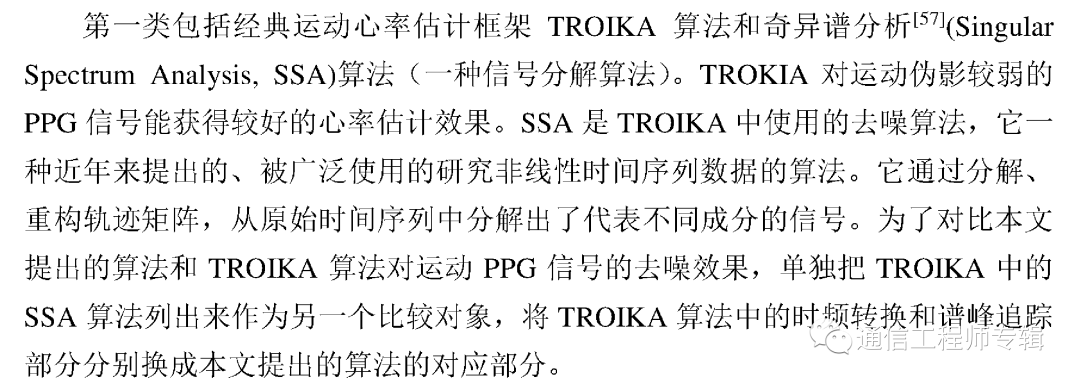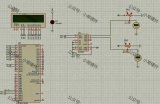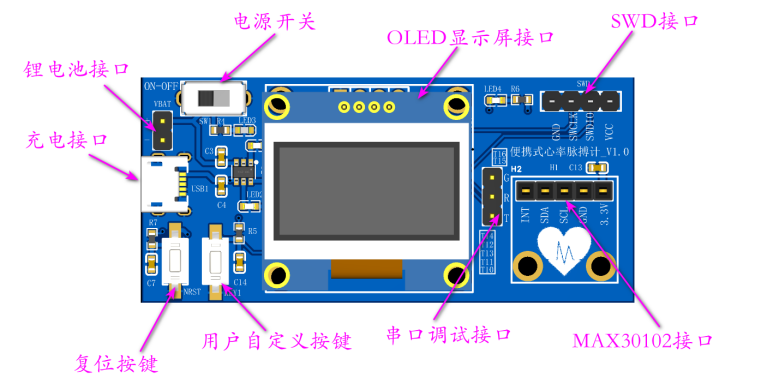繼續講解本人優化心率算法的過程!在完成LMS算法后,對運動下的PPG信號如何去噪有了較深的總結!此時需要理論的加持,這樣印象才能深刻。這也是學習循序漸進的方式!目前有三類去噪的方式!

有關TROIKA算法的論文已經被我下載了!
一起看看本人的分析過程!
文章提及在運動狀態下,用FFT得到的周期譜圖會有一些缺點!在matlab中,函數periodogram是用來計算信號的功率譜密度。怎么用呢?舉例說明!該函數和FFT函數的作用是有一定聯系的!
Fs=1000; % 采樣頻率
n=0:1/Fs:1;
x=cos(2*pi*40*n)+3*cos(2*pi*100*n)+randn(size(n));
nfft=1024;
window=boxcar(length(n));
[Pxx,f]=periodogram(x,window,nfft,Fs);
P=10*log10(Pxx);
plot(f,P);
holdon;
Pxx_1=abs(fft(x,nfft)).^2/length(n);
Due tothe leakage effect, the spectral peak associated with the HR cannot be separated from the peak associated with the handswing rhythm. Thus an error in HR estimation could occur.
Compared to nonparametric spectrum estimation methods such as Periodogram, the SSR-based(sparse signal reconstruction) spectrum estimationfeatures high spectrum resolution, low estimation variance, andincreased robustness. Compared to conventional line spectralestimation methods, the SSR-based spectrum estimation doesnot require model selection and has improved estimationperformance.
此時引出了稀疏信號重建算法!Since MA contaminated PPG signals may not have sparse/compressivespectra, SSR needs preprocessing to sparsify the spectra.
由于還有其他原因,因此需要通過多個步驟來完成心率譜峰的檢測,從而引出了TROIKA架構!
a satisfactory framework forHR monitoring during intensive exercise should consists ofthree parts: denoising, high-resolution spectrum estimation,and spectral peak tracking (including peak selection and verifification). Thus we propose the TROIKA framework.
后續系列文章里面會繼續分析該框架!
再看第二類和第三類!
LMS算法就是第三類算法!

等到自己寫好LMS算法的濾波程序后,急不可耐的開始觀察各時間段信號的頻譜(就因為這個急導致寫錯了語句)!連續觀察六段信號!每段時常40秒。觀察的過程也是算法逐漸完善的過程。有了理論基礎,如何一步一步的實現呢?必須配合實際數據的仿真結果,然后在其中尋找規律!本文下半部分給出了LMS算法結合時域心率檢測的程序內容!
責任編輯:haq
-
仿真
+關注
關注
50文章
4124瀏覽量
134005 -
信號
+關注
關注
11文章
2807瀏覽量
77116 -
智能手環
+關注
關注
47文章
796瀏覽量
73098
原文標題:數字信號處理之信號處理仿真 第六章 智能手環之技術應用(12)—心率算法的優化(LMS算法)
文章出處:【微信號:gh_30373fc74387,微信公眾號:通信工程師專輯】歡迎添加關注!文章轉載請注明出處。
發布評論請先 登錄
相關推薦
時域網絡分析儀的原理和應用場景
【「從算法到電路—數字芯片算法的電路實現」閱讀體驗】+內容簡介
【「從算法到電路—數字芯片算法的電路實現」閱讀體驗】+一本介紹基礎硬件算法模塊實現的好書
Pure path studio內能否自己創建一個component,來實現特定的算法,例如LMS算法?
深度識別算法包括哪些內容
基于大數據與深度學習的穿戴式運動心率算法





 LMS算法結合時域心率檢測程序內容
LMS算法結合時域心率檢測程序內容













評論